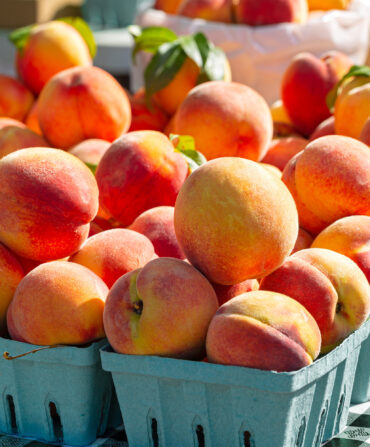On a crisp fall morning on Wadmalaw Island outside of Charleston, South Carolina, Toby Rodriguez stood beside a pig he had killed moments before. The Louisiana chef and butcher described each part of the pig and all the dishes those parts would become at the hands of the chefs gathered along the marsh overlooking Bohicket Creek.
“It’s neither right nor wrong, just what I grew up with,” Rodriguez says of the dishes at this boucherie celebration, titled (aptly) Blood on the River. “These dishes were our backbone. Boudin, cracklings, backbone stew—it’s going to be completely consumed by the end of the day by all y’all.”

Photo: Paul Cheney
Chef Ashley Christensen chats with Louisiana chef and butcher Toby Rodriguez.
The history of boucherie—the French term for a butcher’s shop—dates back to pre-refrigeration days long before cuts of meat were just a trip to the grocery store away. Louisiana neighbors—especially in the Acadiana region—would come together to kill a hog and share all the parts among families who would cook, eat, and process the food right away. Nothing went to waste, and the events turned into festive music-filled community celebrations. Holy City Hogs owner Tank Jackson wanted to bring the tradition to the Lowcountry. He supplied one of his heritage pigs (he raises nearly 300 on Wadmalaw and in Ravenel, South Carolina, with Berkshire, Duroc, and Blonde Mangalitsa lines), and brought rabbits, chickens, ducks, and a turkey.
As Rodriguez explained the butchering process, he passed out parts to chefs—every bit from snout to tail and all the innards. Amidst the jovial Cajun music, chefs including Ashley Christensen from Raleigh, North Carolina, BJ Dennis from Charleston, and David Bancroft from Auburn, Alabama, hushed as they learned what pieces they would be cooking.

Photo: Paul Cheney
From left: Kevin Mitchell, David Bancroft, Blake Field, BJ Dennis, and Marcus Middleton take a break from stirring backbone stew.
“We were dealt ribs with the loin attached,” Christensen says. “When you are expecting loin and ribs all together, you naturally imagine something in the vein of porchetta. When Toby butchered the pig ‘his way’ and handed us the individual chops, it was a really fun trip back to the drawing board.”
Christensen’s team removed the loin, pounded it out, then dredged and pan-fried it in fat that was rendered on site. “We then made gravy from a roux we made from the pan drippings and chopped the loin up and added it back. One of the local farmers brought some of his eggs, so we soft-scrambled the eggs and served the pork gravy on top of the eggs.”
As for the ribs, her team charred them over open flame before nesting them in collards braised with white soy and sprinkled with benne seeds. Meanwhile, chefs from Charleston’s Monza restaurant scrambled up brains and eggs. Bancroft and Dennis stirred a cast iron cauldron of steaming backbone stew.

Photo: Paul Cheney
A pork rib nests atop greens and homemade bread.
“Talking with many of the participating chefs throughout the day, they kept attesting to how much the day’s experience made them appreciate what they would be handling in their kitchens,” Jackson says. “Small-scale farmers have a closer relationship with our animals and crops. People who create their own food know what it takes to reach the plate.”
While the chefs were busy, a fiddler took up his bow, backed by a guitar player. Standing under the pine trees nearby, attendees shucked oysters and sipped homemade cherry juice.
Now in its second year, Jackson plans to make the Lowcountry boucherie an annual one. Today, boucheries dot the Louisiana social calendar, although with considerably less frequency than they once did. Want to experience one for yourself? St. Martinville has held one every fall for nearly fifty years, and Bayou Teche Brewing outside Lafayette, along with Runaway Dish and Lâche Pas Boucherie, will throw one for chefs this month.

Photo: Paul Cheney
A twilight view of Rosebank Plantation.








